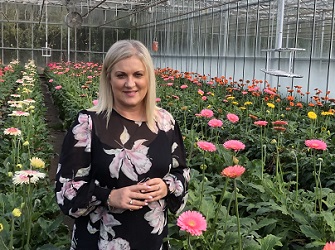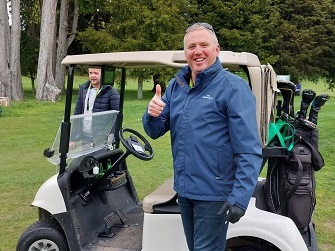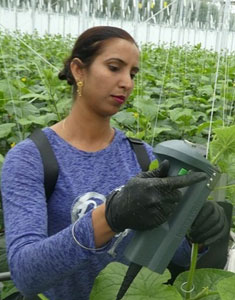Sign up here to subscribe to the Grower2grower Ezine. Every two weeks you will receive new articles, specific to the protected cropping industry, informing you of industry news and events straight to your inbox.

Far red light requires more energy than PAR light, which leads to high additional energy costs.
- Far red light in tomato cultivation gives major differences between varieties.
- It can improve the sink strength and lead to a significant increase in harvest, but it can also negatively affect the quality of the green parts.
- At the moment, far red is not of interest for tomato growers. The production increase is disproportionate to the extra energy required
Growers want to get as much as possible out of their LED lights. That’s why Signify is conducting ongoing research into the optimal application of Philips GreenPower LED lighting for various crops in close collaboration with its partners. Various light recipes are being tested in relation to energy consumption, light spectrum, additional yield, and uniformity. The use of far red has been one of the hot items lately and appears to have a positive effect on many crops when applied properly. Because of this, the question arises for many tomato growers who are already producing under full LED to investigate this?

At the moment, no far-red light is used in tomato cultivation and we do not expect this to change in the foreseeable future. Nevertheless, it is important for us to investigate what cultivation effects we can achieve with different light spectra.
In collaboration with Wageningen University & Research and vegetable breeder Nunhems, we observe unequivocal results when applying far red: we see that the available energy is easier to direct to the fruits. The degree of production increase when adding far-red light depends heavily on the variety. From other studies we see that the crop is slightly easier to control generatively, which sometimes makes it easier to achieve balance in the crop, and the crop may be slightly more forgiving in times when the growing conditions are not optimal. It is therefore too soon to say that far-red light in tomatoes has no effect at all on growth, quality or taste. But how does this translate into practice?

Too uncertain in practice
For growers, the results have been mixed, to say the least. The research shows that there are major differences between varieties. Even when those varieties are genetically very closely related, there may be a huge difference in the effects. Now that breeders are developing new variety portfolios because of the resistance to ToBRFV, this has become an additional uncertain factor. There are also several results from our fundamental research that are difficult to translate into practice. For example, it turned out that different treatments with far red gave the plant better sink strength, which means that more sugars flow to the fruits. However, this only led to a significant increase in harvest if the far-red was dosed during the entire photoperiod — in this case 16 hours a day. The production increase is therefore disproportionate to the extra energy costs required. In general, we see that the effects are greatest with large proportions of far red. This sounds logical, but research also shows that the amount of far red applied in practice in the cultivation of cucumbers and strawberries, for example, has a very limited effect. Recent field trials have also demonstrated this. When we apply 10% of the energy we use for lighting in the form of far-red light, we see the crop react to a limited extent. If we use the same amount of energy for PAR light, this yields equal production in a way that is currently less risky and at least as energy efficient.
Some practical studies even showed negative effects from the use of far red. For example, the quality of the green parts can decline because the cells stretch more. This can be detrimental to the shelf life and potentially even affect the condition of the crop in the longer term. We even had to discontinue a number of studies earlier than planned to keep the crop going.
More costs, too little benefit
In our philosophy, adding far red to the light spectrum only makes sense if it improves the business case of growers. Far red light requires more energy than PAR light, which leads to high additional energy costs. If we take this into account in our practice-based research, we draw a clear conclusion: at the moment, far red is not of interest to the tomato grower. We therefore continue to support our current light recipe for tomato cultivation. If you want healthier plants and more yield, go for MORE light and leave far-red light out of the equation. Of course, Signify always keeps its finger on the pulse. If, for any reason, there is an impetus to take another look at the wisdom or lack thereof in using far red in tomato cultivation, we will not hesitate to take it up!

Erik Stappers is a plant specialist for vegetables at Signify. His focus is on high-wire crops. Erik is closely involved in projects in Western Europe and works together with the growers to create the optimal solution for their crop and situation.
For further information, please contact:
Philips horticulture LED solutions by Signify
Daniela Damoiseaux – global marcom manager
Tel: +316 40578311
E-mail:Daniela.damoiseaux@signify.com
About Signify
Signify (Euronext: LIGHT) is the world leader in lighting for professionals and consumers and lighting for the Internet of Things. Our Philips products, Interact connected lighting systems and data-enabled services, deliver business value and transform life in homes, buildings and public spaces. In 2021, we had sales of EUR 6.9 billion, approximately 37,000 employees and a presence in over 70 countries. We unlock the extraordinary potential of light for brighter lives and a better world. We achieved carbon neutrality in 2020, have been in the Dow Jones Sustainability World Index since our IPO for six consecutive years and were named Industry Leader in 2017, 2018 and 2019. News from Signify is located at the Newsroom, Twitter, LinkedIn and Instagram. Information for investors can be found on the Investor Relations page.
New Zealand Contact:
Graeme Neale
Business Development Manager
Specification, Systems and LED Agriculture Solutions
Mobile + 64 21 2254526
Email graeme.neale@signify.com
Level 3, 123 Carlton Gore Road,
Newmarket, Auckland 1023

Australian Contact:
Aart Slobbe
Account Manager Horticulture LED Solutions
+ 61 448 881 338
Email aart.slobbe@signify.com
Suite 022, 44 Lakeview Drive
Scoresby, VIC 3179, Australia

About Signify
Signify (Euronext: LIGHT) is the world leader in lighting for professionals and consumers and lighting for the Internet of Things. Our Philips products, Interact connected lighting systems and data-enabled services, deliver business value and transform life in homes, buildings and public spaces. With 2020 sales of EUR 6.5 billion, we have approximately 38,000 employees and are present in over 70 countries. We unlock the extraordinary potential of light with smart lighting solutions that improve quality of life, and by working towards a sustainable future. We became a carbon-neutral company in 2020, since our stock market listing, we have been in the Dow Jones Sustainability World Index for four years in a row and were named Industry Leader in 2017, 2018 and 2019. News from Signify is located at the Newsroom, Twitter, LinkedIn and Instagram. Information for investors can be found on the Investor Relations page.
For all media releases please send to marie@grower2grower.co.nz or upload directly: https://www.grower2grower.co.nz/article-form/
CLASSIFIED
Photo
Gallery
Subscribe to our E-Zine
More
From This Category
Den Berk Délice improved production predictability and energy efficiency with Philips horticulture intelligent lighting
Intelligent Philips LED lighting at J&A Chrysanten optimizes production and energy efficiency

A holistic approach in a full LED tomato trial resulted in a 50% reduction in heat input

Increasing year-round Capsicum yields through advanced LED lighting


























































